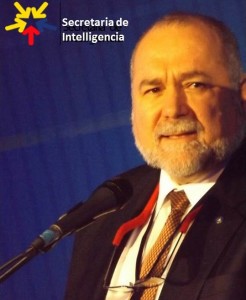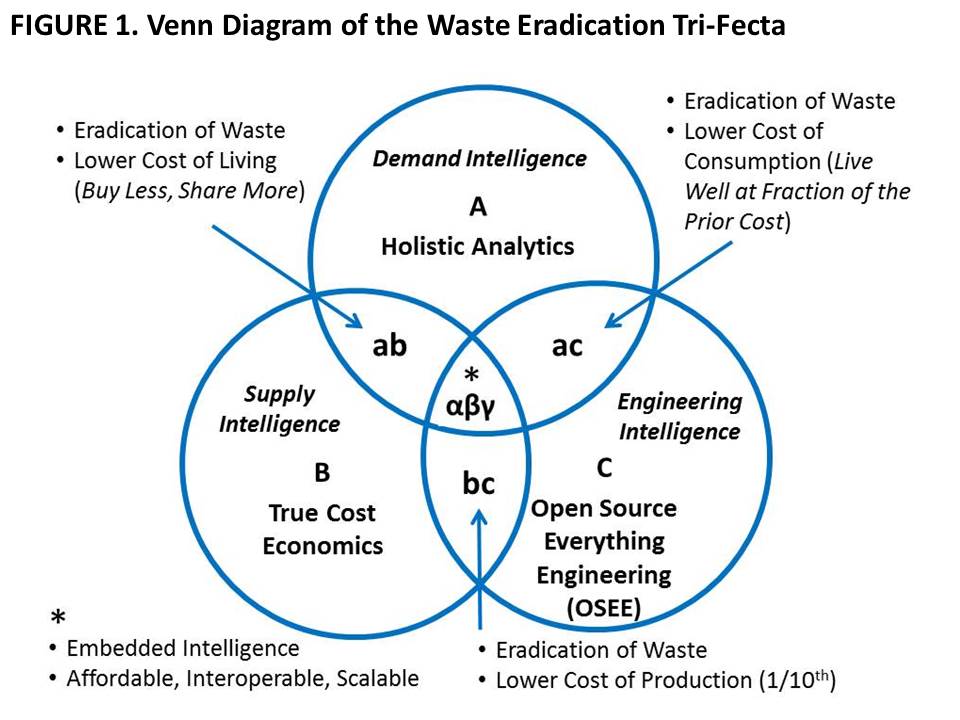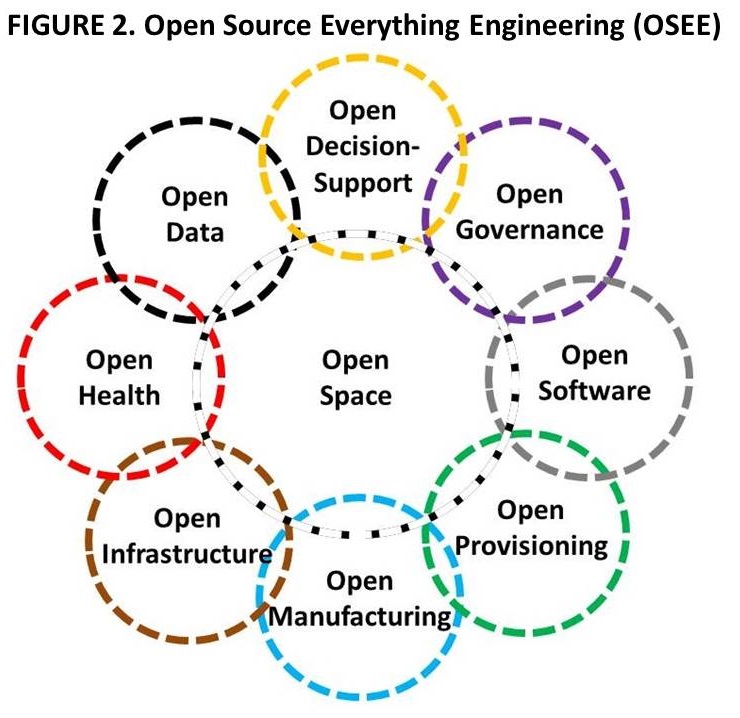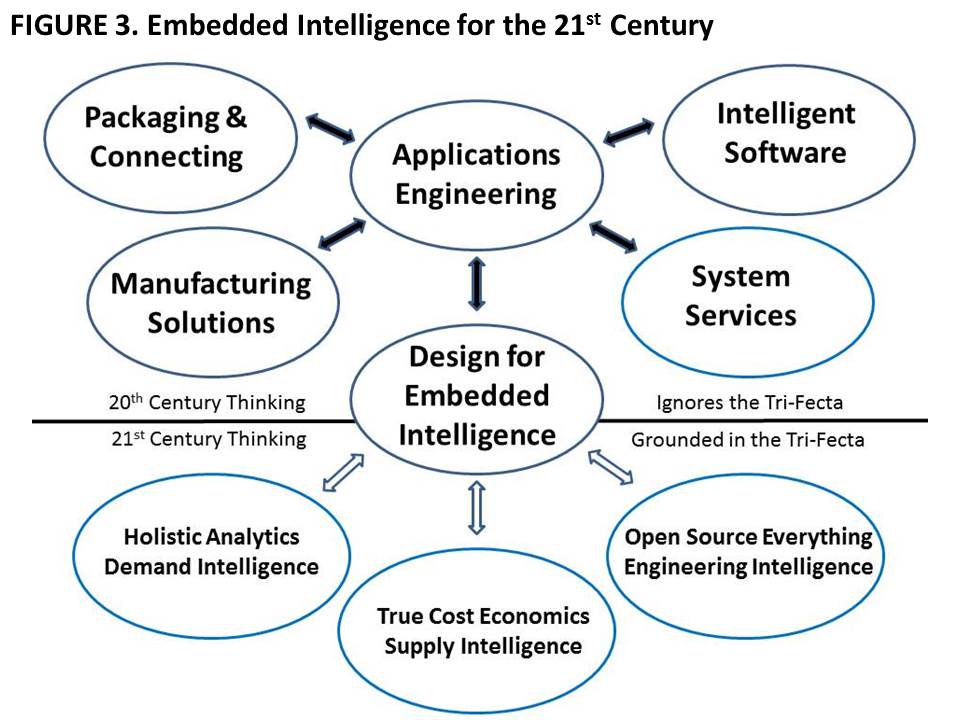 This is what I am taking to the Nordics.
This is what I am taking to the Nordics.
Open Source Everything Engineering (OSEE)
Robert D. Steele, Earth Intelligence Network
Open Source Everything Engineering (OSEE) is affordable, inter-operable, and scalable to the five billion poor now neglected by industrial-era engineers. Data-driven, a design revolution could enable the achievement of the Sustainable Development Goals (SDG) within a decade – two at most – at 1/10th the cost of the current paradigm. An Open Source (Technologies) Agency is proposed as a starting point for the second industrial-informational revolution.
Version 1.6 dated 16 April 2016. Document at end.
DOING THE RIGHT THING
Engineering – the practical application of scientific knowledge to real-world challenges – could be on the verge of a data-driven design revolution equal to and surpassing the industrial revolution. Obstacles to our advance include scientific reductionism,[1] “government specification cost plus” contracting,[2] and an average waste factor across most domains of roughly fifty percent.[3] Other obstacles include legal and financial regimens that perpetuate engineering models devoid of accountability and oblivious of true cost economics.[4] On a positive note, the information revolution has made possible data-driven design innovation, and the emergence of Open Source Software has spawned an ecology that now encompasses all forms of engineering, the term of art being Open Source Everything Engineering (OSEE).[5]
Openness provides higher efficiency, effectiveness, and – in the face of complexity – adaptability. An Open Source (Technologies) Agency (OSA)[6] is proposed as a starting point for the second industrial-informational revolution. Including a World Brain Institute, a Global Game, a School of Future-Oriented Design & Hybrid Governance, and a United Nations Open-Source Decision-Support Information Network (UNODIN), the OSA aspires to re-boot the crafts of intelligence (decision-support) and engineering (the heart of civilization) in order to achieve all of the Sustainable Development Goals (SDG) within a decade (two at the most) at 1/10th the cost of the current industrial-era processes.
THE CHALLENGE—SHIFTING FOCUS
The challenge is one of focus and scale. Engineering today is centered on the one billion rich whose annual aggregate income is roughly one trillion dollars. Largely neglected by engineering today are the five billion poor, whose annual aggregate income is four times larger – four trillion dollars a year. However, the poor need – and can only afford – micro-solutions. Instead of a complex refrigerator requiring reliable electricity, they need a ceramic jar combination to be buried in the ground so as to keep meat fresh for five days.[7] Four times the money, five times the number of customers, but with different (micro) needs. There is a massive vacuum – a massive opportunity – right here right now.
The United Nations (UN) has identified seventeen engineering challenges – the Sustainable Development Goals (SDG)[8] – that no one is taking seriously in part because the current industrial-financial paradigm is not suited to address those challenges. The donations are not materializing; the bulk of the donor money – 80% on average – is spent on intermediaries rather than reaching the village level; and our Western solutions are too expensive, and too wasteful, to scale.[9]
Our challenge is to make engineering relevant to the five billion poor, first at the subsistence or provisioning level, then at the communications and education level, and finally – our master stroke – at the advanced level, creating a global quality of life rooted in peace and prosperity for everyone.
WASTE ERADICATION IS PRIORITY ONE
On a scale of 1 to 100, with 1 representing total waste and 100 representing total efficiency or zero waste – what Buckminster Fuller called “ephemeralism” or doing more with less – the craft of engineering – no matter the type whether chemical, electrical, mechanical, or other – would appear to be at or below the 50% mark, since 50% is the documented average waste across the major engineering domains from agriculture to energy to health to housing to security to water, and beyond. Figure 1 illustrates the importance of three concepts and practices that seek to help engineers eradicate waste by integrating Holistic Analytics, True Cost Economics, and OSEE.[10] The “sweet spot” or the acme of skill, is achieved by embedding intelligence (evidence-based decision-support) into every policy and process and product and behavior such that our scientific achievements are affordable to all, interoperable across all disciplines, and scalable to every point on the planet. A new PhD program – the first “meta” engineering and public administration PhD – is proposed to pursue these possibilities.
Holistic analytics. The problem with all current endeavors is that none of them attempt to define and study all threats simultaneously with all policy domains against all demographics.[11] From an engineering stand-point, we must stop doing the wrong things righter[12] – solving problems in isolation, for contrived markets that are fooled into wanting the solution we have decided to sell them regardless of true cost.
We must recognize that we live within a constellation of complex systems that interact in obscure and unpredictable ways, with multiple failure points that will in turn interact in obscure and unpredictable ways, with failure scaling faster than we can devise solutions as long as we persist in reductionist thinking and unethical engineering. Hence, a necessary pre-condition for doing holistic analytics and true cost economics in support of OSEE is the achievement of 100% access to all knowledge in relation and in real-time, instead of the 1% to 4% that is prevalent today. [13]
If governments and other organizations do not do evidence-based decision-making rooted in holistic analytics of true cost economics with the objective of creating affordable, interoperable, scalable engineering solutions – which is to say, open source solutions now known to cost one tenth what proprietary closed engineering costs,[14] we will soon go well past the tipping points for catastrophic failure across multiple domains including bio-chemical and nuclear accidents, vanishing aquifers, and pandemics.[15] Elective wars destroying entire societies, and the millions of illegal immigrants spawned by those wars are modest challenges, in this larger context.[16] Acts of Man – not Acts of God – are changing the Earth for the worse at an accelerating rate – changes that once took 10,000 years now take three years or less.[17]
Table 1 offers three related perspectives on how best to define our local to global engineering agenda with the observation that today’s governance and financial paradigms over-spend on war at the national level to the detriment of peaceful development engineering that can stabilize the billions of poor, many of them living under repressive regimes that concentrate wealth within a very small elite.
| TABLE 1. Earth Intelligence Network Outline – A Preliminary Holistic Analytic Model[18] | ||
| Ten High-Level Threats | Twelve Core Policy Domains | Selected SDG Challenges |
| 01 Poverty | 01 Agriculture | 01 No Poverty |
| 02 Infectious Disease | 02 Diplomacy | 02 Zero Hunger |
| 03 Environmental Degradation | 03 Economy | 03 Good Health & Well-Being |
| 04 Inter-State Conflict | 04 Education | 04 Quality Education |
| 05 Civil War | 05 Energy | 05 Gender Equality |
| 06 Genocide | 06 Family | 06 Clean Water and Sanitation |
| 07 Other Atrocities | 07 Health | 07 Affordable and Clean Energy |
| 08 Proliferation | 08 Immigration | 10 Reduced Inequalities |
| 09 Terrorism | 09 Justice | 11 Sustainable Cities and Communities |
| 10 Transnational Crime | 10 Security | 13 Climate Action |
| 11 Society | 14 Life Below Water | |
| 12 Water | 15 Life on Land | |
Challenges to holistic analytics include the fragmentation of knowledge workers,[19] the fragmentation of knowledge by domain, language, and medium; and the lack of tools for information-sharing and sense-making across all domains.[20]
Making all information openly available – accessible to and exploitable by the public – is essential if we are to govern the commons with the deep wisdom and understanding that only an engaged informed collective can provide. Top-down hierarchies steeped in secrecy and privilege do not work.[21]
True Cost Economics. We are close to but not yet at a point where everyone appreciates true cost economics as pioneered by Herman Daly and a few others. True cost economics refers to the actual natural capital cost of specific policies, produces, services and behaviors. Today some of us understand the human cost, the social cost, the long-term economic and political cost, of choices including elective wars and legalized financial crime, but this has not become mainstream. Also lacking is the ability to geo-tag all elements of supply and use chains so that we can get to the exact amount of virtual water, fuel consumption, toxins generated, child labor, regulatory violation, and tax avoidance. Table 2 offers a model for thinking about true costs – what is lacking across the board is the actual data for every policy, product, service, and behavior.
| TABLE 2. PriceWaterhouseCoopers (UK) Model for Measuring the All-Around Impact of a Company on Society[22] | |||
| Economic Impact | Social Impact | Environmental Impact | Tax Impact |
| Payroll
Profits Investment Exports Intangibles |
Livelihoods
Health Education Empowerment Community cohesion |
GHGs and other emissions
Water pollution Waste Land use Water use |
Profit taxes
People taxes Production taxes Property taxes Environmental taxes |
PwC has provided a superb starting point, mindful that the data does not exist and most organizations will be reluctant to take on the burden of collecting data absent a public boycott of products that fail to provide true cost economic information at the point of sale.
A tangible data example – one that took a year to compile – for one particular white cotton T-shirt (true costs will vary for the same product depending on which factory, which time of year, and other conditions including weather) is offered here:[23]
- Water: 570 gallons (45% irrigation)
- Energy: 8 kWh (machines), 11 to 29 grams fuel
- Travel: 5,500 to 9,400+ miles
- Emissions: Nox, SO2, CO, CO2, N2O, volatile compounds
- Toxins: 1-3 g pesticides, diesel exhaust, heavy metals (dyes)
- Child Labor: 50 cents a day in any of 17 countries
A more recent example of a true cost not yet grasped by the public is the documentation of why wheat grown in the USA is poisoning humans – it’s not “gluten allergy,” it’s a reaction to a herbicide containing the deadly active ingredient glyphosate being used as a desiccant just prior to the harvesting of the wheat.[24]
Open Source Everything Engineering (OSEE). OSEE is in many ways a return to the indigenous peoples’ approach to civilization-building – one for all and all for one. OSEE is not necessarily “free” nor does it reject the concepts of intellectual property, revenue, and profit. What OSEE does is take “liberation technology” to the next level – achieving more with less (ephemeralism) – while extending the blessings of engineering across the rural environment occupied by the five billion poor.
FIGURE 2 depicts the nine core domains, each of which has three or more sub-domains itemized in TABLE 3. The opens reinforce one another – Open Data is impoverished without Open Software which is strengthened by Open Governance and Open Infrastructure, and so on. Perhaps even more pointedly, absent an extension of the open source mind-set and practice into Open Infrastructure, Open Manufacturing, and Open Provisioning, we will not achieve the SDG goals and elevate the five billion poor.[25]
The next big leap in engineering – the ultimate hack if you will – could be a series of applications that are infinitely scalable at near zero cost, thus impacting most favorably on billions of people in quick time.
A “village in a box” could provide, for example – and at a cost estimated to be no more than $500 per individual[26] – solar power fields for water desalination; potable water tanks and trickle piping; aquaponics start-up kits; several pieces of equipment from the Global Village Construction Set[27] providing the ability to dig and move dirt and create pressed-brick structures; regional cell towers and free cellular phones along with neighborhood wireless mesh kits and one laptop per household; and bits and pieces for composting home sewage, gray water treatment, and so on. After the first wave of boxes dropped by precision-parachute, specialty boxes could be delivered – a solar field box, a water desalination box, a hospital box, a university box, a governance and law enforcement box, etcetera. In approaching the needs of the five billion poor we have it backwards – instead of bringing our infrastructure to them, we should be delivering the fundamentals in open form so as to unleash the unlimited brainpower and energy they have in hand. This would empower them to build out and up as innovators, nor merely be “customers” for Western offerings that are inappropriate, too expensive, and unsupportable in austere environments.
| TABLE 3. Open Source Everything Engineering (OSEE) Building Blocks | |||
| Open Data | Open Geospatial | Open History | Open Language |
| Open Decision-Support | Open Access | Open Document | Open Research |
| Open Governance | Open Money | Open Politics | Open Standards |
| Open Health | Open Cures | Open Drugs | Open Procedures |
| Open Infrastructure | Open API* | Open BTS** | Open Spectrum |
| Open Manufacturing | Open Circuits | Open Hardware | Open Materials |
| Open Provisioning | Open Energy | Open Food | Open Water |
| Open Software | Free Software | Libre Software | Open Code |
| Open Space | Open Cities | Open Design | Open Innovation |
| * Application Program Interface ** Base Transceiver Station | |||
EMBEDDED INTELLIGENCE
Embedded Intelligence (EI) is a term of art for a vision that stops short.[28] As with the original concept of “Smart Cities,” it assumes that merely adding IT to existing artifacts, or using IT to enhance existing design, packaging, manufacturing, and system services, somehow embeds intelligence in Applications Engineering.[29] 21st Century thinking brings to bear the tri-fecta of Holistic Analytics, True Cost Economics, and Open Source Everything Engineering (OSEE) so as to eradicate waste in every form. Some waste can be eradicated through consumer and decision-maker education, to include the provision of true cost economic facts at the point of sale; some waste can be eradicated by process engineering that squeezes out the virtual water, excess fuel, toxin creation, and with commercial intelligence, identifies and shuts out actors who are guilty of using child labor, violating environmental and other regulations, or simply avoiding their civic, social, and taxation obligations.
BEYOND WASTE TO WEALTH CREATION
The eradication of waste is the first step toward data-driven design in which solutions are devised that are completely natural and sustainable. We cease drawing down on natural capital, we cease poisoning humanity and the Earth, and we begin the second industrial revolution, this time living up to our ethical precepts to include doing nothing further to endanger the public or the environment.[30]
The human brain is the one infinite resource we have.[31] Our first priority should be to create at least one Open Source (Technology) Agency that could in turn inspire replicates in other countries. Such an agency, with a clear mission to support Defense, Diplomacy, & Development (D3), would be divided into a D3 Information Bureau and a D3 (Engineering) Innovation Bureau. Among its elements would be a shared global World Brain Institute; a Global Game allowing all citizens in all locations voice and vote over all issues and investments; a School of Future-Oriented Design & Hybrid Governance; and ideally, a United Nations Open-Source Decision-Support Information Network (UNODIN) – if the latter cannot be achieved immediately, then a Nordic Intelligence Centre devoted to inspiring peace instead of war, prosperity instead of predatory capitalism, should be considered.
Our second priority must be the combined goal of achieving free energy with unlimited water desalination on the one hand, and the elimination of all elective toxins in our present processes on the other.[32]
Our third priority should be the restoration of the roles of education (learn to think), intelligence (inform), and research (investigate and innovate for the good of all). A new “meta” doctoral level program with master and bachelor level feeds is needed, one that offers the above tri-fecta as three tracks, with candidates choosing one track as their major.
The key component of this vision is openness – transparency, truth, & trust are the Holy Trinity.
– – – – – – – – – – – – – – – – – – – – – – – – – – –
Robert David Steele is the founder and pro bono Chief Executive Officer of Earth Intelligence Network, an accredited non-profit educational association. He has forty years’ experience across most aspects of diplomatic, informational, military, and economic (DIME) operations. View his complete biography and most publications online at http://robertdavidsteele.com. Contact him at robert.david.steele.vivas@gmail.com.
PRINTABLE DOCUMENT: Steele OSEE Nordic Manifesto 1.6
REFERENCES
[1] Cf. Monica Anderson, “Science Beyond Reductionism,” SpaceCollective, 14 June 2010, the commentary “Yoda: MIT Hypes Artificial Intelligence – All Ying, No Yang,” Phi Beta Iota Public Intelligence Blog [hereafter PBI] 20 October 2015, and the broad literature on reductionism.
[2] Chuck Spinney, “Defense Dependency,” TIME (Battleland), 13 November 2012, elaborated upon in “Killing America – Government Specifications Cost Plus,” PBI, 14 November 2012.
[3] Agriculture: Nadia Arumugam, “UN Says Europe Wastes 50% of Fruit and Vegetables – and America Isn’t Much Better,” Forbes,4 October 2012, Dana Gunders, “Wasted: How America is Losing Up to 40 Percent of Its Food from Farm to Fork to Landfill,” National Resources Defense Council, August 2012; Energy: Barry Fischer, “US Wastes 61-86% Of Its Energy,” CleanTechnica, 26 August 2013; Health: Michael Galper et al, “The price of excess: Identifying waste in healthcare spending,” PriceWaterhouseCoopers, April 2008; Military: Scot Paltrow, “Behind the Pentagon’s doctored ledgers, a running tally of epic waste,” Reuters, 18 November 2013, Stockholm International Peace Research Institute, “The US spends more on defense than the next eight countries combined,” Peter G. Peterson Foundation, 13 April 2014, Perry Chiaramonte, “War on waste: Pentagon auditor spotlights US billions blown in Afghanistan,” Fox News, 28 July 2014; Water: Robert David Steele, “Water: Soul of the Earth, Mirror of Our Collective Souls,” Huffington Post , 7 January 2011.
[4] Matt Taibbi, Griftopia: A Story of Bankers, Politicians, and the Most Audacious Power Grab in American History, Spiegel & Gau, 2011. See also John Bogle, The Battle for the Soul of Capitalism, Yale University Press, 2006; and William Greider, The Soul of Capitalism: Opening Paths to a Moral Economy, Simon & Schuster, 2003. True cost economics was pioneered by Herman Daly with Ecological Economics: Principles and Applications, Island Press, 2003 and has spawned an entire literature. The broader term includes human and social costs. Two compelling cases for changing our economic and engineering paradigm are offered by Peter Linebaugh, Stop, Thief!: The Commons, Enclosures, and Resistance, PM Press, 2014, and Charles Bednar, Transforming the Dream: Ecologism and the Shaping of an Alternative American Vision, State University of New York, 2003.
[5] Robert David Steele, The Open Source Everything Manifesto: Transparency, Truth, & Trust, North Atlantic Books Evolver Editions, 2012. There are over sixty opens itemized in book.
[6] Robert Steele, Memorandum for the Vice President, Supporting the President’s Interest in 2015 Defense, Diplomacy, and Development Innovation – the Open Source (Technologies) Agency, Digital Deserts, & Global Stabilization, PBI, 8 October 2015.
[7] C. K. Prahalad, The Fortune at the Bottom of the Pyramid: Eradicating Poverty Through Profits, Wharton School Publishing, 2009; Clayton Christensen, The Innovator's Dilemma: The Revolutionary Book That Will Change the Way You Do Business, HarperBusiness, 2011.
[8] Sustainable Development Goals: 17 Goals to Transform Our World, United Nations, 25 September 2015.
[9] Charles Lwanga Ntale, “Where does aid money really go – what is it spent on,” CNN, 9 October 2013. Justin Elliott, “How the Red Cross Raised Half a Billion Dollars for Haiti and Built Six Homes, Pro Publica, 3 June 2015.
[10] This illustration was created for me by Bojan Radej after reading some of my early work. See also his paper, Social Complexity, Slovenian Evaluation Society, Working paper 7/2 (June 2014), also published at PBI, 12 June 2014.
[11] The countries whose population mass will define the future include Brazil, China, India, Indonesia, and Russia, with countries such as the Congo, Iran, South Africa, and Turkey having substantive potential in their own right.
[12] Russell Ackoff, “Transforming the Systems Movement,” RLA Conference Paper, 26 May 2004.
[13] Mary Meeker, Internet Trends Report 2014, KPCB, 28 May 2014; Erik Stokstad, “The 1% of Scientific Publishing,” Science, 11 July 2014; Yoda, “Google—By Its Own Admission—Indexes Less Than 0.04% of the Internet,” PBI, 10 December 2010, citing James Bruce, “18 Fun Interesting Facts You Never Knew About the Internet,” MakeUseOf, 10 December 2010; “Graphic: OSINT and Missing Information,” PBI, 24 January 2010.
[14] Marcin Jacubowski, “Global Village Construction Set,” Open Source Ecology Wiki, 2016. Since stating there “The cost of making or buying our machines is, on average, 8x cheaper than buying from an Industrial Manufacturer” he has confirmed in personal communications that savings are now approaching 10X.
[15] Charles Perrow, The Next Catastrophe: Reducing Our Vulnerabilities to Natural, Industrial, and Terrorist Disasters, Princeton University Press, 2007; Joseph Thornton, Pandora’s Poison: Chlorine, Health, and a New Environmental Strategy, MIT Press, 2001.
[16] Chalmers Johnson, The Sorrows of Empire: Militarism, Secrecy, and the End of the Republic, Metropolitan Books, 2005; William Blum, Killing Hope: US Military and CIA Interventions Since World War II – Updated Edition, Zed Books, 2014; James Risen, Pay Any Price: Greed, Power, and Endless War, Houghton Mifflin Harcourt, 2014.
[17] Ted Steinberg, Acts of God: The Unnatural History of Natural Disaster in America, Oxford University Press, 2006; Eugene Linden, The Winds of Change: Climate, Weather, and the Destruction of Civilizations, Simon & Schuster, 2006.
[18] Column 1 is from United Nations High-Level Panel on Threats, Challenges, and Change, A More Secure World: Our Shared Responsibility, United Nations, 2004; Column 1 is from Earth Intelligence Network Flyer, 2012, drawing in turn on various presidential transition teams; Column 3 is from Supra Note 7.
[19] Robert David Steele, “SPECIAL FEATURE: Creating a Smart Nation–Strategy, Policy, Intelligence, and Information,” Government Information Quarterly, pp. 159-173. Eight “tribes” that do not share information well: academic, civil society including labor unions and religions, commerce especially small business, government especially local, law enforcement, media including specialty press, military, and non-government/non-profit.
[20] Micah Sifry, The Big Disconnect – Why the Internet Hasn’t Transformed Politics (Yet), O/R Books, 2014; Robert David Steele, “Foreword,” in Stephen E. Arnold, CyberOSINT: Next Generation Information Access, Harrods Creek, KY: Arnold Information Technology, 2015.
[21] Elinor Ostrom, Governing the Commons: The Evolution of Institutions for Collective Action, Cambridge University Press, 1990; Tom Atlee, The Tao of Democracy: Using Co-Intelligence to Create a World that Works for All, The Writers’ Collective, 2010. There are too many books on the pathologies of secrecy to be listed here. Secrecy is a form of engineering cancer – it distorts or withholds truth from those who need it to do good engineering.
[22] The table is based on a graphic from Dennis Nally, “Measuring the impact of a company on society: how to gain an all-round view,” Brewery Journal, January 2014, Figure 1, p. 30. An improved version of the graphic is online.
[23] Jason “JZ” Liszkiewicz, “Graphic: The Cost of a Cotton T-Shirt,” PBI, 16 April 2011.
[24] Sarah (sic), “The Real Reason Wheat is Toxic (it’s not the gluten), The Health Home Economist, November 2014. The author notes that the practice of using RoundUp is refused by the beer, pea, and lentil marketplaces, and that the Soil Association has called for an end to this practice.
[25] Michel Bauwens, founder of the Peer to Peer (P2P) Foundation and its Wiki, is one of the foremost proponents for new approaches to community-centric economics including the sharing economy. He created the original Category:Open and the new Category:Open Source Everything. His own initiatives, the Commons Transition and Open Cooperativism, merit study by engineers interested in shaping the future.
[26] Robert David Steele, “$500 Million to Resettle 1 Million on a Moonscape with Sun, Dirt, & Salt Water….Exploring the Practical Edge of Intelligence with Integrity — 2.0 Habitat Cost Sheet Posted,” PBI, 25 June 2013.
[27] As designed and created by Dr. Marcin Jakubowski, founder of Open Source Ecology; the fifty industrial devices sufficient to create a small sustainable civilization, can be seen at Global Village Construction Set.
[28] The upper half of Figure 3 was inspired by the Centre for Doctoral Training in Embedded Intelligence at Loughborough University in the United Kingdom.
[29] The India Smart Cities Challenge originated as a plan to make broadband the defining characteristic of a smart city, but has evolved rapidly toward finding and adapting all good ideas across all domains.
[30] IEEE Code of Ethics, accessed 14 April 2016.
[31] “Graphic: Jim Bamford on the Human Brain,” PBI, 28 December 2009.
[32] Additional materials by the author can be found at The Future: Recent “Core” Work by Robert Steele, PBI. See in particular 2016 Robert Steele: The Ultimate Hack – Resilient Villages, Smart Cities, Prosperous Nations at Peace — and Unlimited Clean Water.







